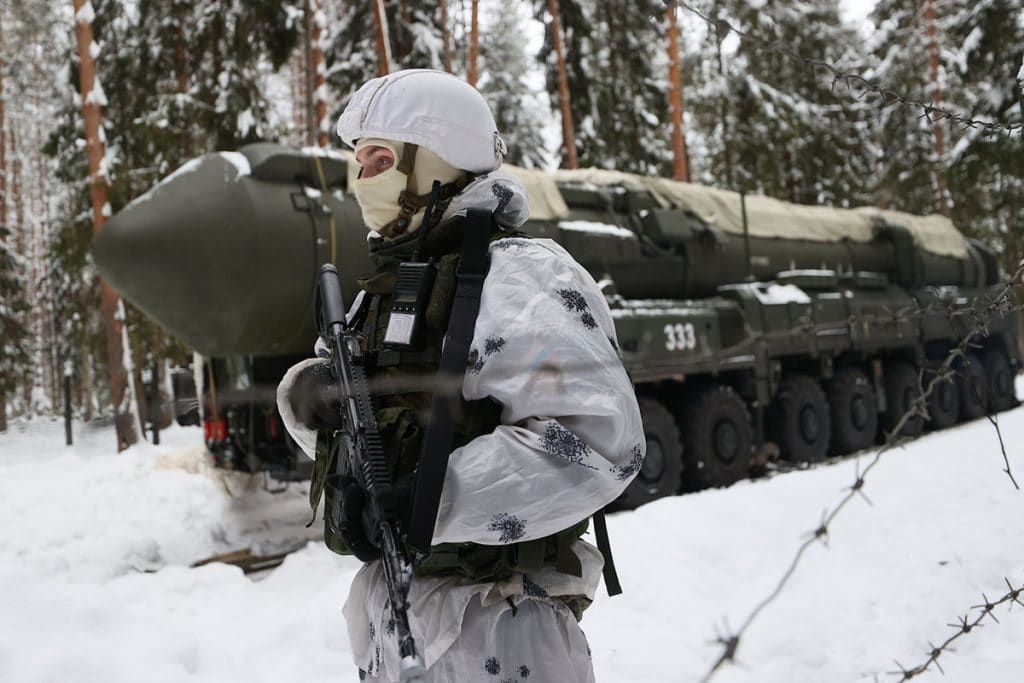How to mix sanctions and diplomacy to avert disaster in Ukraine
By David Cortright, George A. Lopez | February 1, 2022
 Exercise with Teikovsky missile unit. Credit: Ministry of Defence of the Russian Federation. CC BY 4.0.
Exercise with Teikovsky missile unit. Credit: Ministry of Defence of the Russian Federation. CC BY 4.0.
After a month of intensive political work at home and with allies abroad, the Biden administration may have assembled the right mix of sanctions and related policy tools to forestall Russian military action against Ukraine. The success of sanctions, according to our research, relies on four factors. First, sanctions must be multilateral in design, implementation, and enforcement. Second, in both their threat and multi-stage imposition, they must be clear, credible, and powerful. Third, all parties that threaten economic sanctions must be willing to incur costs. Finally, the sanctions must not simply be punitive but must be accompanied by diplomatic efforts to resolve the crisis.
World citizens await news about how Putin will proceed in a crisis of his own making on the Ukrainian border. As they wait, they have reason to be cautiously optimistic that Biden is pursuing a textbook model of sound economic statecraft that may reduce the likelihood of war.
The sanctions are multilateral. Rather than proceeding directly to impose sanctions, the Biden administration has spent the past month rallying European allies. He sought to have them join US sanctions and pursue direct diplomatic engagement with Russia to end the crisis. Multilateral sanctions are more likely to succeed than unilateral measures, according to one study.
The United States and several European countries are also working together on diplomatic efforts. The United States has initiated talks with Russia on East-West strategic issues such as the future of NATO expansion, the alignment of Russian and NATO military forces in the region, and possible arms control agreements. Meanwhile, Germany and France have engaged Ukraine and Russia in talks to address conflict issues within Ukraine. These engagements are in their early stages, but observers are already seeing modest progress.
French President Macron had a one-hour phone call with President Putin last Friday to reaffirm France’s commitment to Ukraine’s independence. While Russian Minister of Foreign Affairs Sergey Lavrov said last week that the US proposal for talks on strategic issues contains a “kernel of rationality,” there is no evidence yet of the two sides closing the differences that divide them. Yet Russia, Ukraine, Germany and France produced a statement from their talks indicating that they would respect and fully adhere to the cease-fire agreement negotiated previously in the Minsk accords.
The sanctions are clear, powerful, and multi-stage. The Biden administration’s extensive sanction proposals were developed in coordination with Senate Foreign Relations Committee Chair Bob Menendez of New Jersey, a Democrat. Menendez and his Senate colleagues developed bi-partisan legislation to impose sanctions that will damage the Russian economy deeply and quickly if Russia invades Ukraine.
These sanctions fall into two general categories: financial restrictions and export controls. The financial sanctions target Russia’s most powerful banks from participating in the dollar-based economy. They also cut access to the SWIFT system of global financial communications and credit facilitation. The export sanctions prohibit firms and countries from exporting to Russia technological equipment that uses US-built or US-designed microchips.
Barring Russian firms from the dollar economy and denying access to SWIFT would severely and quickly devastate Russia’s powerful energy export sector. Access to Western credit markets and foreign investment would dry up. Without hard currency financing, the Russian economy would experience significant chaos, some of which will likely reverberate negatively back to Europe. A senior official of Germany’s Christian Democratic Union has warned that unplugging Russia from the SWIFT system would be “an atomic bomb for the financial markets.”
Regarding the export sanctions, the United States already imposed microchip sanctions on Russian aerospace firms in 2014. The new sanctions reportedly would more broadly target Russia’s growth sectors and strategic industries, including the oil and gas sector and its aircraft and arms industries. In 2019, Washington’s microchip sanctions against the Chinese tech firm Huawei led to a collapse of the company’s international sales. No one knows whether such sanctions would have the same impact on Russian firms.
The United States and Europe are willing to incur the cost of sanctions. While a Russian invasion of Ukraine would destabilize the world, the prospective sanctions would negatively impact the US and European economies. Yet if the sanctions are to succeed, the United States and its European allies will need to preserve multilateral unity and endure these costs. Europe’s annual trade with Russia is nearly $200 billion, which far surpasses America’s $30 billion. In this scenario, Europe has a lot to lose—even more than the United States.
Germany has deferred final decisions on the Nord Stream 2 pipeline between Germany and Russia until July, risking a colder winter and gas shortages in the months ahead. Slower gas deliveries from Russia have already led to higher prices for European consumers. Foreign Minister Annalena Baerbock nonetheless told parliament in Berlin that Germany is preparing a strong package of sanctions covering many aspects “including Nord Stream 2.”
If the United States threatens to use export control mechanisms to stop the supply of microchips to Russia, it will introduce additional risks to the global economy. Weaponizing the semiconductor industry would likely have ripple effects on supply chains, especially at a time of chip shortages. “We are in uncharted waters,” said an industry representative after being briefed about the new sanctions by White House officials.
The sanctions encourage diplomatic engagement. Washington’s concrete threat of strong sanctions, with support from European states, shows Moscow the high price it will pay if it invades Ukraine. Threats can be an effective means of obtaining concessions, especially when the expected costs of sanctions in the targeted regime are high, as they are in this case.
All sides claim to have no interest in war. To guarantee this goal, the United States must now move ahead with new urgency and all diplomatic tools working overtime. These range from tough negotiations with Russia to forge mutual concessions, sustained cooperation with European allies, and passage of the US Senate sanctions bill to solidify sanctions leverage. Sanctions-based diplomacy offers the best option for avoiding a military confrontation, especially the one currently brewing on the Russia-Ukraine border which would no doubt have catastrophic consequences.
Together, we make the world safer.
The Bulletin elevates expert voices above the noise. But as an independent nonprofit organization, our operations depend on the support of readers like you. Help us continue to deliver quality journalism that holds leaders accountable. Your support of our work at any level is important. In return, we promise our coverage will be understandable, influential, vigilant, solution-oriented, and fair-minded. Together we can make a difference.
Keywords: Putin, Russia, Ukraine, diplomacy, nuclear risk, nuclear weapons, sanctions
Topics: Nuclear Risk, Nuclear Weapons
















This crisis is a slow-motion train wreck that has been developing for a quarter century; ever since Bill Clinton decided to extend NATO membership to Poland, Hungary, and Czech Republic in the late 1990s. As George Kennan famously noted, the outcome of extending NATO east of a reunified Germany was entirely predictable. The West (read United States) had a golden, once in a century opportunity to reset the security architecture of Europe when the Soviet Union imploded. All we had to do was say “mission accomplished” and disestablish NATO at the same time that Russia dissolved the Warsaw Pact. After all, Dwight Eisenhower… Read more »